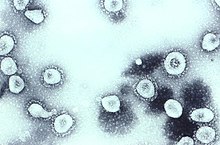| Betacoronavirus gravedinis | |
|---|---|

| |
| Transmission electron micrograph of human coronavirus OC43 | |
| Virus classification | |
| (unranked): | Virus |
| Realm: | Riboviria |
| Kingdom: | Orthornavirae |
| Phylum: | Pisuviricota |
| Class: | Pisoniviricetes |
| Order: | Nidovirales |
| Family: | Coronaviridae |
| Genus: | Betacoronavirus |
| Subgenus: | Embecovirus |
| Species: | Betacoronavirus gravedinis
|
| Member viruses[1] | |
| Synonyms | |
Betacoronavirus gravedinis [4] (also called Betacoronavirus 1) is a species of coronavirus which infects humans and cattle.[5][6] The infecting virus is an enveloped, positive-sense, single-stranded RNA virus and is a member of the genus Betacoronavirus and subgenus Embecovirus.[7] Like other embecoviruses, it has an additional shorter spike-like surface protein called hemagglutinin esterase (HE) as well as the larger coronavirus spike protein.[8][9]
- ^ de Groot, R.J; et al. (2009). "ICTV 9th Report (2011) New Coronaviridae". International Committee on Taxonomy of Viruses (ICTV). Archived from the original on 23 January 2020. Retrieved 23 January 2020.
- ^ a b c d e f de Groot, Raoul J.; et al. (2009). "Revision of the family Coronaviridae" (PDF). International Committee on Taxonomy of Viruses (ICTV). p. 18. Archived (PDF) from the original on 7 February 2019. Retrieved 23 January 2020.
A new species, Betacoronavirus 1, is proposed to accommodate previously established Betacoronavirus species of humans, cattle, swine and horses (Human enteric coronavirus; Human coronavirus OC43; Bovine coronavirus; Porcine hemagglutinating encephalomyelitis virus; Equine coronavirus) and a newly recognized virus of dogs (canine respiratory coronavirus; Erles et al., 2007)
- ^ ICTV 5th Report Francki, R. I. B., Fauquet, C. M., Knudson, D. L. & Brown, F. (eds)(1991). Classification and nomenclature of viruses. Fifthreport of the International Committee on Taxonomy of Viruses. Archives of Virology Supplementum 2, 452 pp. https://ictv.global/ictv/proposals/ICTV%205th%20Report.pdf [1]
- ^ "Taxon Details | ICTV". International Committee on Taxonomy of Viruses (ICTV). Archived from the original on 26 July 2024.
- ^ "Virus Taxonomy: 2018b Release" (html). International Committee on Taxonomy of Viruses (ICTV). March 2019. Archived from the original on 4 March 2018. Retrieved 23 January 2020.
- ^ Lim, Yvonne Xinyi; Ng, Yan Ling; Tam, James P.; Liu, Ding Xiang (2016-07-25). "Human Coronaviruses: A Review of Virus–Host Interactions". Diseases. 4 (3): 26. doi:10.3390/diseases4030026. ISSN 2079-9721. PMC 5456285. PMID 28933406.
See Table 1.
- ^ "Taxonomy browser (Betacoronavirus 1)". www.ncbi.nlm.nih.gov. Retrieved 2020-02-29.
- ^ Woo, Patrick C. Y.; Huang, Yi; Lau, Susanna K. P.; Yuen, Kwok-Yung (2010-08-24). "Coronavirus Genomics and Bioinformatics Analysis". Viruses. 2 (8): 1804–1820. doi:10.3390/v2081803. ISSN 1999-4915. PMC 3185738. PMID 21994708.
In all members of Betacoronavirus subgroup A, a haemagglutinin esterase (HE) gene, which encodes a glycoprotein with neuraminate O-acetyl-esterase activity and the active site FGDS, is present downstream to ORF1ab and upstream to S gene (Figure 1).
- ^ Woo, Patrick C. Y.; Huang, Yi; Lau, Susanna K. P.; Yuen, Kwok-Yung (2010-08-24). "Coronavirus Genomics and Bioinformatics Analysis". Viruses. 2 (8): 1804–1820. doi:10.3390/v2081803. ISSN 1999-4915. PMC 3185738. PMID 21994708.
The presence of HE genes exclusively in members of Betacoronavirus subgroup A, but not members of Betacoronavirus subgroup B, C and D suggested that the recombination had probably occurred in the ancestor of members of Betacoronavirus subgroup A, after diverging from the ancestor of other subgroups of Betacoronavirus.